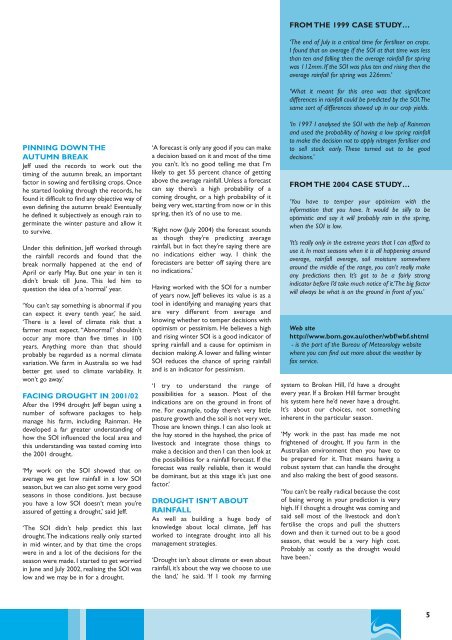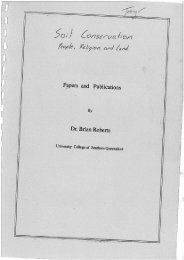Masters of the Climate: Innovative farmers ... - South West NRM
Masters of the Climate: Innovative farmers ... - South West NRM
Masters of the Climate: Innovative farmers ... - South West NRM
You also want an ePaper? Increase the reach of your titles
YUMPU automatically turns print PDFs into web optimized ePapers that Google loves.
PINNING DOWN THE<br />
AUTUMN BREAK<br />
Jeff used <strong>the</strong> records to work out <strong>the</strong><br />
timing <strong>of</strong> <strong>the</strong> autumn break, an important<br />
factor in sowing and fertilising crops. Once<br />
he started looking through <strong>the</strong> records, he<br />
found it difficult to find any objective way <strong>of</strong><br />
even defining <strong>the</strong> autumn break! Eventually<br />
he defined it subjectively as enough rain to<br />
germinate <strong>the</strong> winter pasture and allow it<br />
to survive.<br />
Under this definition, Jeff worked through<br />
<strong>the</strong> rainfall records and found that <strong>the</strong><br />
break normally happened at <strong>the</strong> end <strong>of</strong><br />
April or early May. But one year in ten it<br />
didn’t break till June. This led him to<br />
question <strong>the</strong> idea <strong>of</strong> a ‘normal’ year.<br />
‘You can’t say something is abnormal if you<br />
can expect it every tenth year,’ he said.<br />
‘There is a level <strong>of</strong> climate risk that a<br />
farmer must expect. “Abnormal” shouldn’t<br />
occur any more than five times in 100<br />
years. Anything more than that should<br />
probably be regarded as a normal climate<br />
variation. We farm in Australia so we had<br />
better get used to climate variability. It<br />
won’t go away.’<br />
FACING DROUGHT IN 2001/02<br />
After <strong>the</strong> 1994 drought Jeff began using a<br />
number <strong>of</strong> s<strong>of</strong>tware packages to help<br />
manage his farm, including Rainman. He<br />
developed a far greater understanding <strong>of</strong><br />
how <strong>the</strong> SOI influenced <strong>the</strong> local area and<br />
this understanding was tested coming into<br />
<strong>the</strong> 2001 drought.<br />
‘My work on <strong>the</strong> SOI showed that on<br />
average we get low rainfall in a low SOI<br />
season, but we can also get some very good<br />
seasons in those conditions. Just because<br />
you have a low SOI doesn’t mean you’re<br />
assured <strong>of</strong> getting a drought,’ said Jeff.<br />
‘The SOI didn’t help predict this last<br />
drought.The indications really only started<br />
in mid winter, and by that time <strong>the</strong> crops<br />
were in and a lot <strong>of</strong> <strong>the</strong> decisions for <strong>the</strong><br />
season were made. I started to get worried<br />
in June and July 2002, realising <strong>the</strong> SOI was<br />
low and we may be in for a drought.<br />
‘A forecast is only any good if you can make<br />
a decision based on it and most <strong>of</strong> <strong>the</strong> time<br />
you can’t. It’s no good telling me that I’m<br />
likely to get 55 percent chance <strong>of</strong> getting<br />
above <strong>the</strong> average rainfall. Unless a forecast<br />
can say <strong>the</strong>re’s a high probability <strong>of</strong> a<br />
coming drought, or a high probability <strong>of</strong> it<br />
being very wet, starting from now or in this<br />
spring, <strong>the</strong>n it’s <strong>of</strong> no use to me.<br />
‘Right now (July 2004) <strong>the</strong> forecast sounds<br />
as though <strong>the</strong>y’re predicting average<br />
rainfall, but in fact <strong>the</strong>y’re saying <strong>the</strong>re are<br />
no indications ei<strong>the</strong>r way. I think <strong>the</strong><br />
forecasters are better <strong>of</strong>f saying <strong>the</strong>re are<br />
no indications.’<br />
Having worked with <strong>the</strong> SOI for a number<br />
<strong>of</strong> years now, Jeff believes its value is as a<br />
tool in identifying and managing years that<br />
are very different from average and<br />
knowing whe<strong>the</strong>r to temper decisions with<br />
optimism or pessimism. He believes a high<br />
and rising winter SOI is a good indicator <strong>of</strong><br />
spring rainfall and a cause for optimism in<br />
decision making.A lower and falling winter<br />
SOI reduces <strong>the</strong> chance <strong>of</strong> spring rainfall<br />
and is an indicator for pessimism.<br />
‘I try to understand <strong>the</strong> range <strong>of</strong><br />
possibilities for a season. Most <strong>of</strong> <strong>the</strong><br />
indications are on <strong>the</strong> ground in front <strong>of</strong><br />
me. For example, today <strong>the</strong>re’s very little<br />
pasture growth and <strong>the</strong> soil is not very wet.<br />
Those are known things. I can also look at<br />
<strong>the</strong> hay stored in <strong>the</strong> hayshed, <strong>the</strong> price <strong>of</strong><br />
livestock and integrate those things to<br />
make a decision and <strong>the</strong>n I can <strong>the</strong>n look at<br />
<strong>the</strong> possibilities for a rainfall forecast. If <strong>the</strong><br />
forecast was really reliable, <strong>the</strong>n it would<br />
be dominant, but at this stage it’s just one<br />
factor.’<br />
DROUGHT ISN’T ABOUT<br />
RAINFALL<br />
As well as building a huge body <strong>of</strong><br />
knowledge about local climate, Jeff has<br />
worked to integrate drought into all his<br />
management strategies.<br />
‘Drought isn’t about climate or even about<br />
rainfall, it’s about <strong>the</strong> way we choose to use<br />
<strong>the</strong> land,’ he said. ‘If I took my farming<br />
FROM THE 1999 CASE STUDY…<br />
‘The end <strong>of</strong> July is a critical time for fertiliser on crops.<br />
I found that on average if <strong>the</strong> SOI at that time was less<br />
than ten and falling <strong>the</strong>n <strong>the</strong> average rainfall for spring<br />
was 112mm. If <strong>the</strong> SOI was plus ten and rising <strong>the</strong>n <strong>the</strong><br />
average rainfall for spring was 226mm.’<br />
‘What it meant for this area was that significant<br />
differences in rainfall could be predicted by <strong>the</strong> SOI.The<br />
same sort <strong>of</strong> differences showed up in our crop yields.<br />
‘In 1997 I analysed <strong>the</strong> SOI with <strong>the</strong> help <strong>of</strong> Rainman<br />
and used <strong>the</strong> probability <strong>of</strong> having a low spring rainfall<br />
to make <strong>the</strong> decision not to apply nitrogen fertiliser and<br />
to sell stock early. These turned out to be good<br />
decisions.’<br />
FROM THE 2004 CASE STUDY…<br />
‘You have to temper your optimism with <strong>the</strong><br />
information that you have. It would be silly to be<br />
optimistic and say it will probably rain in <strong>the</strong> spring,<br />
when <strong>the</strong> SOI is low.<br />
‘It’s really only in <strong>the</strong> extreme years that I can afford to<br />
use it. In most seasons when it is all happening around<br />
average, rainfall average, soil moisture somewhere<br />
around <strong>the</strong> middle <strong>of</strong> <strong>the</strong> range, you can’t really make<br />
any predictions <strong>the</strong>n. It’s got to be a fairly strong<br />
indicator before I’d take much notice <strong>of</strong> it.’The big factor<br />
will always be what is on <strong>the</strong> ground in front <strong>of</strong> you.’<br />
Web site<br />
http://www.bom.gov.au/o<strong>the</strong>r/wbf/wbf.shtml<br />
- is <strong>the</strong> part <strong>of</strong> <strong>the</strong> Bureau <strong>of</strong> Meteorology website<br />
where you can find out more about <strong>the</strong> wea<strong>the</strong>r by<br />
fax service.<br />
system to Broken Hill, I’d have a drought<br />
every year. If a Broken Hill farmer brought<br />
his system here he’d never have a drought.<br />
It’s about our choices, not something<br />
inherent in <strong>the</strong> particular season.<br />
‘My work in <strong>the</strong> past has made me not<br />
frightened <strong>of</strong> drought. If you farm in <strong>the</strong><br />
Australian environment <strong>the</strong>n you have to<br />
be prepared for it. That means having a<br />
robust system that can handle <strong>the</strong> drought<br />
and also making <strong>the</strong> best <strong>of</strong> good seasons.<br />
‘You can’t be really radical because <strong>the</strong> cost<br />
<strong>of</strong> being wrong in your prediction is very<br />
high. If I thought a drought was coming and<br />
said sell most <strong>of</strong> <strong>the</strong> livestock and don’t<br />
fertilise <strong>the</strong> crops and pull <strong>the</strong> shutters<br />
down and <strong>the</strong>n it turned out to be a good<br />
season, that would be a very high cost.<br />
Probably as costly as <strong>the</strong> drought would<br />
have been.’<br />
5
















